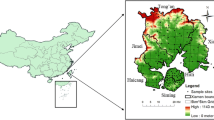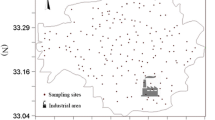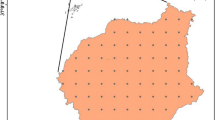Abstract
Several studies have examined the role of changes in the natural and anthropogenic factors of soil heavy metals; however, the causes of spatial heterogeneity of soil heavy metals remains to be understood. To study heavy metals in soil, we collected a total of 134 soil samples from diverse land-use types; whereby we measured the concentrations of six metals (Cr, Ni, Cu, Zn, As, and Pb). Herein, we used Kriging interpolation methods in a geographic information system (GIS) and geo-accumulation index to map the distribution and evaluate the pollution of heavy metals in soil. We applied geographic detector models, a new spatial statistical method, to determine how the dominant factors and interactions led to spatial heterogeneity of heavy metal variations in soil, in the northern Chengdu Plain in western China. The results indicated that the overall pollution of heavy metals in soil was relatively light, with Cr, Ni, Cu, Zn, As, and Pb in soil reaching 5.37%, 22.15%, 22.82%, 17.45%, 4.70%, and 27.52%, respectively. We observed that heavy metals in soil demonstrated significant spatial heterogeneity, with high Cr and Ni contents in the central region and low in the south and north; Cu was high and widely distributed in the western parts, exceeding the background value; Zn was high in the north and west, and low in the east, covering a wide area with significantly high contents; As was high in the west and central parts, and low in the north, south, and east; Pb was high in the north and central parts, and low in the south. The results revealed that the dominant factors affecting the spatial heterogeneity of Cr in soil were moisture content, available phosphate, and distance to factory; the explanatory power was 31.52%, 25.77%, and 10.71%, respectively. Moisture content, organic matter, and available phosphate most significantly influenced Cu and Pb in soil, with explanatory powers of 13.11%, 8.20%, 3.21%, 10.55%, 10.49%, and 11.87%, respectively. The available phosphate, moisture content, and soil type can explain the spatial heterogeneity of Zn in soil, with explanatory powers of 31.52%, 2 5.77%, and 10.71%, respectively; whereas the dominant factors affecting the spatial heterogeneity of As in soil were soil type, slope, and geomorphic type, with explanatory powers of 16.11%, 6.68%, and 6.40%, respectively. Moisture content, soil type, and GDP had the greatest influence on Ni in soil, with explanatory powers of 1.4%, 0.77%, and 0.62%, respectively. This study suggests that the interactions among impact factors mutually and non-linearly enhance the impact of a single factor on the spatial heterogeneity of soil heavy metals. Our research highlights that the geodetector method is an effective approach to disentangle the complicated driving factors and reveal the optimum characteristics and ranges of each factor, further contributing to our understanding of the spatial heterogeneity of soil heavy metals and the driving mechanisms. Our results are useful for providing theoretical contributions and practical references to accelerate the formulation of land pollution management policies.





Similar content being viewed by others
References
Adagunodo TA, Akinloye MK, Sunmonu LA, Aizebeokhai AP, Oyeyemi KD, Abodunrin FO (2018a) Groundwater exploration in Aaba residential area of Akure, Nigeria. Front Earth Sci 6:1–12
Adagunodo TA, Sunmonu LA, Emetere ME (2018b) Heavy metals’ data in soils for agricultural activities. Data Brief 18:1847–1855
Adagunodo TA, Sunmonu LA, Adabanija MA, Omeje M, Odetunmibi OA, Ijeh V (2019) Statistical assessment of radiation exposure risks to farmers in Odo Oba, Southwestern Nigeria. Bull Miner Res Explor 159:201–217
Adewoye AO, Ajibade TT, Adewoye SO, Olagunju TE, Adagunodo TA (2021) Pollution indices and health risk assessment of heavy metals in floodplain of urban catchment of Asa drainage systems, Southwestern Nigeria. IOP Conf Ser Earth Environ Sci 655:012091. https://doi.org/10.1088/1755-1315/655/1/012091
Beijing: China Agricultural Press (1992) A systematic approach to soil nutrient status:1–16
China National Environmental Montioring Center. Ed (CNEM) (1992) Recent analytical methods of soil elements. China Environment Science Press, Beijing
Cai LM, Jiang HH, Luo J (2019a) Metals in soils from a typical rapidly developing county, Southern China: levels, distribution, and source apportionment. Environ Sci Pollut Res 26:19282–19293
Cai LM, Wang QS, Luo J, Chen LG, Zhu RL, Wang S, Tang CH (2019b) Heavy metal contamination and health risk assessment for children near a large Cu-smelter in central China. Sci Total Environ 650:725–733
Cai LM, Wang QS, Wen HH, Luo J, Wang S (2019c) Heavy metals in agricultural soils from a typical township in Guangdong Province, China: occurrences and spatial distribution. Ecotoxicol Environ Qual Saf 168:184–191. https://doi.org/10.1016/j.ecoenv.2018.10.092
Chen YY, Tang MY, Wang ST, Wang Q, Zhan WX, Huang G (2016) Heavy metal pollution assessment of farmland soil in China based on bibliometrics. China J Soil Sci 47(1):219–225
Chen JL, Li RY, Xie XJ, Wang H, Xu J, Shao J, Jian J, Wuerman AJ, Shen J, Yang Z (2020a) Distribution characteristics and pollution evaluation of heavy metals in greenbelt soils of Nanjing City. Environ Sci. https://doi.org/10.13227/j.hjkx.202005203
Chen WX, Qian Li, Wang Z, Sun ZJ (2020b) Spatial distribution characteristics and pollution evaluation of heavy metals in arable land soil of China. Environ Sci 41(6):2822–2833
Deng L, Li Z, Wu LH, Liu HY, Luo YM (2014) Effects of moisture and drying process on availability of heavy metals in soil. Soil 46(06):1045–1051
Galley FA, Lloyd OL (1985) Grass and surface soils as monitors of atmospheric metal pollution in central Scotland. Water Air Soil Pollut 24(1):1–18
Guo XX, Liu CQ, Zhu ZZ, Wang ZL, Li J (2011) Evaluation methods for soil heavy metals contamination: a review. Chin J Ecol 30(5):889–896
Han W, Wang CW, Peng M, Wang QL, Yang Fan XR (2020) Characteristics and origin of heavy metals in soil and crops in mountain area of Southern Sichuan. Environ Sci. https://doi.org/10.13227/j.hjkx.202008257
He JY, Yang Y, Christakos G, Liu YJ, Yang X (2019) Assessment of soil heavy metal pollution using stochastic site indicators. Geoderma 337:359–367
Hu Y, Cheng H (2013) Application of stochastic models in identification and apportionment of heavy metal pollution sources in the surface soils of a large-scale region. Environ Sci Technol 47:3752–3760
Jia ZB, Zhou H, Zhao ZJ, Tao S, Zhang BQ, Zhao LH (2000) Assessment of heavy metal pollution in sediments of Taizihe River by using land accumulation index method. J Peking Univ (Nat Sci) 04:525–530
Li LH, Wang BL (2008) Geochemical characteristics of as and Cd in soils of Yunnan Province. 32(5):497–501
Li B, Wang CQ, Tan T, Li HX, Yang J, Li QG, Yuan Q (2009) Regional distribution and pollution evaluation of heavy metal pollution in top soils of the Chengdu plain. J Nucl Agric Sci 23(2):308–315
Li QQ, Zhang SY, Dai TF, Gao XS, Zhang X, Wang CQ, Yuan DG, Li KR (2014) Contents and sources of cadmium in farmland soils of Chengdu Plain, China. J Agro-Environ Sci 33(5):898–906
Li C, Li F, Wu Z, Cheng J (2017a) Exploring spatially varying and scale-dependent relationships between soil contamination and landscape patterns using geographically weighted regression. Appl Geogr 82:101–114
Li HX, Ji HB, Shi CJ, Gao Yang ZY, Xu XY, Ding HJ, Tang L, Xing YX (2017b) Distribution of heavy metals and metalloids in bulk and particle size fractions of soils from coal-mine brownfield and implications on human health. Chemosphere 172:505–515
Li S, Li QQ, Wang CQ, Li B, Gao XS, Li YD, Wu DY (2019) Spatial variability of soil bulk density and its controlling factors in an agricultural intensive area of Chengdu Plain, Southwest China. J Integr Agric 18(2):290–300
Li J, Zhang MG, Zhong XY, Wang XY, Ouyang XD, Zhao XJ (2020a) The accumulation characteristics and influencing factors of heavy metals in soil-crop system in typical karst areas in Guangxi. Acta Sci Circumtantiae 41(2). https://kns.cnki.net/kcms/detail/11.1843.X.20201114.1323.002.html
Li C, Georgina M, Sanchez, Wu ZF, Cheng J, Zhang SY, Wang Q, Li FB, Ge S, Ross K Meentemeyer (2020b) Spatiotemporal patterns and drivers of soil contamination with heavy metals during an intensive urbanization period (1989–2018) in southern China. Environ Pollut 260:114075. https://doi.org/10.1016/j.envpol.2020.114075
Liao Q, Li JX, Li MZ, Dong YP, Wu M, Meng ZL, Li MH, Liu AJ (2018) Cumulative distribution and risk assessment of heavy metals during sewage irrigation. J Agro-Environ Sci 37(11):2560–2569
Liu YS, Li JT (2017) Geographic detection and optimizing decision of the differentiation mechanism of rural poverty in China. Acta Geogr Sin 72(1):161–173
Lu RK (2000) Analytical methods for soil and agro-chemistry. China Agricultural Science and Technology Press, Beijing
Luo XS, Xue Y, Wang YL, Cang L, Xu B, Ding J (2015) Source identification and apportionment of heavy metals in urban soil profiles. Chemosphere 127:152–157
Meng XF, Guo JM, Yang JX, Yang J, Zheng GD, Qiao PW, Bian JL, Chen TB (2020) Spatial distribution and risk assessment of heavy metal pollution in farmland soils surrounding the typical industrial area in Henan Province. Environ Sci. https://doi.org/10.13227/j.hjkx.202005321
Mianzhu Statistics Bureau (2020) Mianzhu statistical yearbooks. Sichuan Science and Technology Publishing House, Chengdu
Ministry of Environmental Protection, Ministry of Land and Resources (2014) National soil pollution survey bulletin. Ministry of Environmental Protection of the People’s Republic of China, Beijing
Muller G (1969) Index of geoaccumulation in sediments of the Rhine River. Geochem J 2(3):108–118
Nanos N, Rodriguez Martin J (2012) Multiscale analysis of heavy metal contents in soils: spatial variability in the Duero river basin (Spain). Geoderma 189–190(6):554–562
Pan L, Wang Y, MaJ HuY, Su B, Fang G, Wang L, Xiang B (2018) A review of heavy metal pollution levels and health risk assessment of urban soils in Chinese cities. Environ Sci Pollut Res 25:1055–1069
Peng Y, Wu J, Chao JB, Chen Y (2017) A method for the accurate determination of 14 metal elements in soils/sediments by ICP-MS. Environ Chem 36(1):175–182
Peng WF, Kuang TT, Tao S (2019) Quantifying influences of natural factors on vegetation NDVI changes based on geographical detector in Sichuan, western China. J Clean Prod 233:353–367
Penteado JO, de Lima Brum R, Ramires PF, Garcia EM, dos Santos M, da Silva Júnior FMR (2021) Health risk assessment in urban parks soils contaminated by metals, Rio Grande city (Brazil) case study. Ecotoxicol Environ Saf 208. https://doi.org/10.1016/j.ecoenv.2020.111737
Qin YS, Yu H, Feng WQ, Wang ZY, Tu SH (2013) Assessment on heavy metal pollution status in paddy soils in the northern Chengdu Plain and their potential ecological risk. Acta Ecol Sin 33(19):6335–6344
Qu C, Shi W, Guo J, Fang BB, Wang S, Giesy JP, Holm PE (2016) China’s soil pollution control: choices and challenges. Environ Sci Technol 50(24):13181–13183
Rehman ZU, Khan S, Shah MT, Brusseau ML, Khan SA, Mainhagu J (2021) Transfer of heavy metals from soils to vegetables and associated human health risk in selected sites in Pakistan. Pedosphere. https://doi.org/10.1016/S1002-0160(17)60440-5
Song H, Hu K, An Y, Chen C, Li G (2018) Spatial distribution and source apportionment of the heavy metals in the agricultural soil in a regional scale. J Soils Sediments 18:852–862
Toth G, Hermann T, Da Silva MR (2016) Heavy metals in agricultural soils of the European Union with implications for food safety. Environ Int 88:299–309
Wang YN, Xie JM, Guo X (2008) Geostatistical Kriging interpolation in ArcGIS and its application. Softw Guide 7(12):36–38
Wang YQ, Li SY, Cai XD (2010) Advance of research on sewage irrigation in farmland in China. Tianjin Agric Sci 16(4):77–80
Wang JF, Zhang TL, Fu BJ (2016) A measure of spatial stratified heterogeneity. Ecol Ind 67:250–256
Wang GY, Zhang SR, Xiao LY, Zhong QM, Li LX, Xu GR, Deng OP, Pu YL (2017a) Heavy metals in soils from a typical industrial area in Sichuan, China: spatial distribution, source identification, and ecological risk assessment. Environ Sci Pollut Res 24(20):16618–16630
Wang YJ, Wu TL, Zhou DM, Chen MH (2017b) Advances in soil heavy metal pollution evaluation based on bibliometrics analysis. J Agro-Environ Sci 36(12):2365–2378
Wang HZ, Cai LM, Wang QS, Hu GC, Chen LG (2021) A comprehensive exploration of risk assessment and source quantification of potentially toxic elements in road dust: a case study from a large Cu smelter in central China. CATENA 196:104930. https://doi.org/10.1016/j.catena.2020.104930
Xiang ZX, Bing HJ, Wu YH, Zhang WLR, Chen YQ (2017) On pollution assessment of Cd, Cu, Ni, Pb, Zn in surburban vegetation soil of Chengdu. J Southwest Normal Univ (Nat Sci Ed) 42(9):151–158
Xing XL (2009) Basin-mountain scale transport of persistent organic pollutants in the soil and atmospheric environment: a case study along the West Edge of Sichuan Basin. China University of Geosciences, Wuhan
Xing XL, Qi SH, Odhiambo JO, Zhang Y, Liu YP (2009) Influence of environmental variables on spatial distribution of organochlorine pesticides in Sichuan, West China. Environ Earth Sci 59:215–222
Xu YH, Tang Y, Zhang CS, Wang JY, Li B (2010) Assessment of road dust and soil heavy metal content in Jiuzhaigou scenic spot, Sichuan Province. Acta Montane Sinica 28(03):288–293
Yan XL, Sun CZ, Hu YM, Zhong JD (2021) Effect of reclamation on soil heavy metal content of coastal wetland ecological risk assessment in Northern Liaodong Bay, China. Acta Ecol Sin 41(3). https://doi.org/10.5846/stxb20190861654
Yang A, Xing WC, Wang XX, Hu J, Liu XL (2020) Li J (2020) Source and risk assessment of heavy metals in surface sediments of rivers, lakes and their surrounding soils in central Tibet. China Environ Sci 40(10):4557–4567
Zeng WB, Gu GQ, Wan XM, Lei M (2020) Heavy metal contents of soil and surface dust and its ecological risk analysis in a multifunctional industrial park. Environ Sci. https://doi.org/10.13227/j.hjkx.202010267
Zhou JJ, Zhou J, Feng RG (2014) Status of China’s heavy metal contamination in soil and its remediation strategy. Bull Chin Acad Sci 29(3):315–320
Zhou YJ, Jia ZY, Wang JX, Chen L, Zou MM, Li Yan, Zhou SL (2019) Heavy metal distribution, relationship and prediction in a wheat-rice rotation system. Geoderma 354. https://doi.org/10.1016/j.geoderma.2019.113886
Acknowledgements
The authors thank the editors and anonymous referees for their valuable comments and suggestions, which have helped improve the manuscript. Landsat data were acquired from the USGS EROS Data Center and Data Centre for Resources and Environmental Sciences, Chinese Academy of Sciences (RESDC) (http://www.resdc.cn).
Funding
Funding for this study was provided by the Humanities and Social Science Research Foundation of the Ministry of Education, China (No. 17YJA850007) and the National Natural Science Foundation of China (No. 41371125; No. 32060370). The funding sources were not involved in the collection, analysis, and interpretation of data, the writing of the report, or the decision to submit the article for publication.
Author information
Authors and Affiliations
Contributions
All of the authors contributed materially to the study, have reviewed and approved the manuscript, and agreed with submission to the journal.
Corresponding author
Ethics declarations
Conflict of interest
The authors declare no competing interests.
Additional information
Responsible Editor: Stefan Grab
This manuscript has not been published or presented elsewhere in part or in entirety, and is not under consideration by another journal. All of the authors contributed materially to the study, have reviewed and approved the manuscript, and agreed with submission to the journal. The authors have no conflicts of interest to declare.
Rights and permissions
About this article
Cite this article
Wang, G., Peng, W., Zhang, D. et al. Detection of dominant factors and interactions of spatial heterogeneity of soil heavy metals in northern Chengdu Plain, western China. Arab J Geosci 15, 592 (2022). https://doi.org/10.1007/s12517-022-09603-4
Received:
Accepted:
Published:
DOI: https://doi.org/10.1007/s12517-022-09603-4




